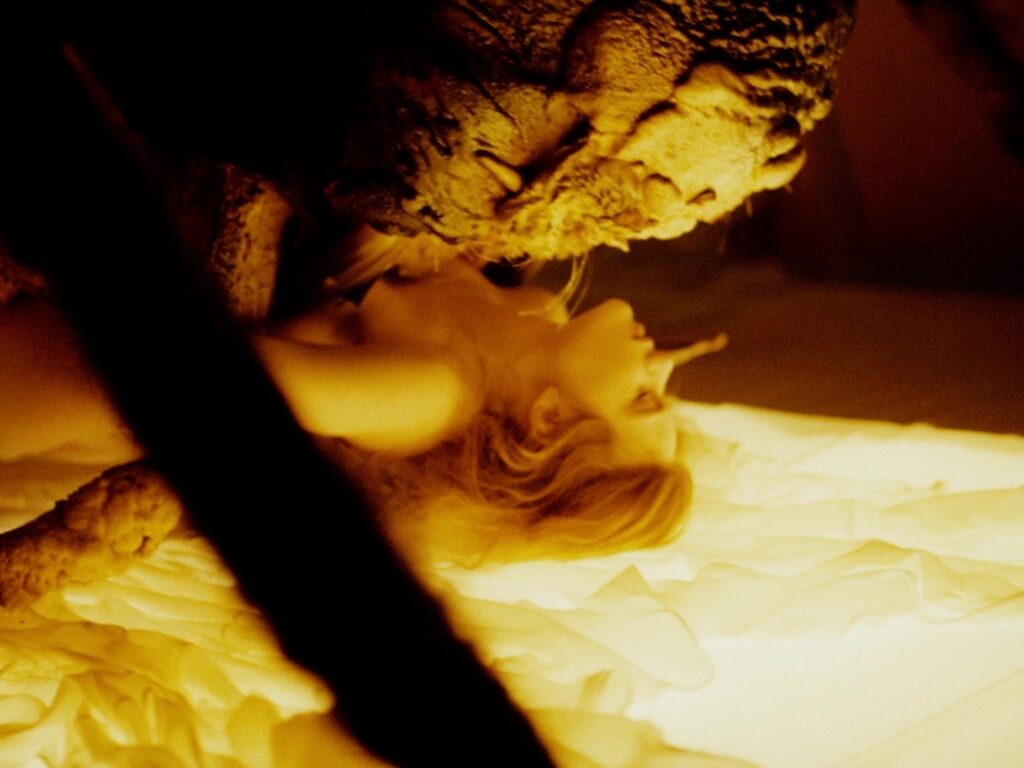
Vasilijs Mass’ Zirneklis (1992) feels remarkably like a fairytale film while never truly committing to the genre. Zirneklis (or Spider in english) is packed to the brim with dreamy erotic imagery, Gothic settings and a macabre atmosphere, but all of this is suggested to be the providence of a teenage girl’s subconscious. The absence of persistent literal manifestations of the fantastic in Zirneklis render it parallel to rather than apart of Eastern Europe’s fairytale film tradition.
This isn’t a bad thing, it makes Zirneklis feel fresh and more surprising in some respects, particularly during the finale in the steam bath. Like Robert Sigl’s Laurin (1989) and Jaromil Jireš’ Valerie And Her Week Of Wonders (1970) post-modern renderings of the fairytale film, Zirneklis is primarily concerned with the panic, both internal and external, surrounding the sexual awakening of a teenage girl. The perspective these filmmakers and their cultures have regarding female sexuality is largely formed by both their gender and a Christian world view. It’s hardly surprising that all three films feel like 19th century texts even if their narratives occupy a different time and place.
What Zirneklis adds to the fairytale elements it employs is a kind of body horror designed to reflect the repulsiveness that the protagonist Vita (Aurelijia Anuzhite) feels in conjunction with her desires for older men. From the beginning Mass makes it clear that Zirneklis is a Freudian fantasy; interjecting modern psychology into the economy of 19th century Gothic, giving the narrative a sort of temporal transcendence. On a subconscious level Vita clearly reciprocates the painter Albert’s (Liubomiras Laucevicius) desires, going so far as to fetishize her own fear of a sexual encounter with Albert by dreaming of having intercourse with a gigantic spider.
The spectacles of sexual fantasy that Vasilijis Mass has constructed in Zirneklis are the greatest strength of the film. Where the narrative falters the images sustain. Mass paints fabulously expressionistic tableaus that he then overlays, one upon the other, transitioning back and forth in time with slow dissolves, creating a practical effect that emotes the lyricism inherent in the unreality of dreams. There are three moments like this that stand out in Zirneklis as more remarkable than the rest. The first occurs at Albert’s studio where Vita is seemingly consumed by the world within the artist’s paintings. The second comes later where Vita fantasizes about being bound and caressed by an executioner. The final fantasy comes while Vita sleeps in a hammock midday, dreaming of sex with a huge demonic spider.
That Vita’s sexual awakening manifests itself in a series of highly erotic yet improbable set pieces pinpoints another aesthetic intersection, though this time with the erotic anthology films of Walerian Borowczyk and Pier Paolo Pasolini. Fairytales, myths, legends as well as folklore in general comprise the erotica in Borowczyk and Pasolini’s films. So does a common interest in 18th century novels that chart the moral downfall of a virtuous teenage heroine. Zirneklis fits in here nicely, even if it leans more toward the fairytale genre on a production design level.
Under seen and relatively neglected in the West, Zirneklis is a fine addition to the East European tradition of erotic fantasy films. Zirneklis was released onto BluRay by Mondo Macabro some time ago in a really nice home video edition that I can personally vouch for. The film looks incredible in 1080p which is essential to appreciating the amazing images Mass has filled Zirneklis with. This one gets a very strong recommendation to the cult film fanatics out there.
